Are bull terriers aggressive? This is a common question among most pet parents, ranging from those that already own bull terriers to those planning to bring these dogs home.
The plain answer to that question is yes. Compared to many other dog breeds, Bull Terriers pack a higher degree of aggression. But as you shall find out, the answer isn’t as cut and dried as it may sound.
As you might already know, various factors influence a dog’s temperament and behavioral characteristics. For instance, dogs that were originally bred for hunting are characterized by their intrinsic prey drive.
Similarly, dogs that were bred to offer companionship and emotional support are generally calm and mellow.
Most dog trainers admit that if you don’t take your Bull Terrier through early training and socialization, it will inevitably become aggressive.
And not only are Bull Terriers intolerant to other dogs, but their aggressive tendencies also manifest when they’re in the company of human strangers. That might help explain why most experts don’t recommend Bull Terriers for first-time pet owners.
But if you’re a strong-willed, assertive, and dominant pet parent, then these terriers may just be the ideal dog for you.
Table of Contents
Fun Facts and Special Highlights of Bull Terriers
Before we delve further into what makes Bull Terriers generally aggressive, let’s have a look at some quick facts about this dog breed.
1. Bred to fight and hunt
Bull Terriers trace their origin in Britain. The dogs were primarily bred for use in blood sports, such as dog fighting and bull baiting.
Bull Terriers are the result of a cross between the strong and muscular bulldog breeds, and the quicker and more agile terrier breeds. Incidentally, these were the two primary characteristics that qualified a dog for blood sports.
Bull Terriers were also developed to hunt vermin, a task that required the dogs to be resilient and courageous.
But in the 1830s, blood sports was outlawed. As a result, most Bull Terriers were taken in as pets. The dogs were mostly associated with the fashionable elite in society.
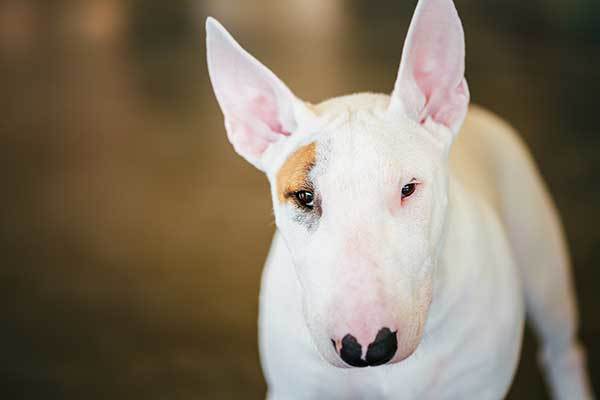
2. Highly domineering characteristics
Bull Terriers are highly territorial and domineering. They have a very strong prey drive, and most successful chases often end up in serious injuries.
Terriers will not share a home peacefully with other dogs, cats, and smaller pets.
That means you should generally avoid dog parks, or at least have your dog in a basket muzzle or on a leash. If the park also features other Bull Terriers, you might carry citronella spray to keep them at bay.
However, males and females, or two females, may tolerate each other. It’s the males that generally don’t entertain one other, and un-neutered males will readily attack other dogs. Due to their domineering traits, owning a Bull Terrier may mean it’s the only dog you have.
[thrive_leads id=’7777′]3. Intelligent and independent thinkers
Bull Terriers are highly intelligent dogs. Besides, they’re also independent thinkers and strong-willed, which means they won’t follow you blindly even if you’re its owner.
If you’re too soft on the dog, it may eventually take over and throw you lower on the family pecking order.
To prevent this, you should always be calm but assertive when dealing with these terriers. Their stubbornness makes them somewhat difficult to train. Training them requires heightened patience and tolerance.
Even when you think your terrier has become more tolerant around other dogs and people, it won’t hesitate to confront a perceived threat. But above all, early socialization can help lessen Bull Terriers’ aggressive tendencies.
4. Protective of their owners
Much as they are aggressive and obstinate, Bull Terriers are highly protective of their owners.
In fact, these dogs are quite possessive and jealous. Being so highly sensitive, a little act of mischief towards their owners is all it takes for them to get worked up.
Thankfully, Bull Terriers thrive in the company of their human owners, and are relatively adaptable to apartment living. But if left alone for extended durations, the dogs might develop separation anxiety. And should the boredom persist, they may take to destructive behavior.
[thrive_text_block color=”note” headline=””]ALSO READ: Why Are Pit Bulls So Popular? What Are Pit Bulls Known For? [/thrive_text_block]5. Full of energy
Bull Terriers are so full of energy that they aren’t ideal for families with very young children. These terriers won’t hesitate to play rough and are only perfect for older kids who can keep up with their explosive energies.
They are also attention-seeking dogs known for their clownish behavior. And though they are highly-playful and demonstrate some degree of mouthiness, Bull Terriers are relatively quiet dogs who don’t bark or howl often.

6. General Maintenance
Bull Terriers require between 30 minutes to one hour of exercise, playtime, and mental stimulation daily. These terriers aren’t suited for cold, damp climates.
Grooming-wise, they’re fairly low-maintenance dogs who only require weekly brushing and occasional wipe-down.
So, Why Are Terriers So Aggressive?
We’ve already mentioned that Bull Terriers were bred for hunting, fighting, and for use in blood sports, which mostly accounts for their aggression.
But while most Bull Terriers are inherently violent, that doesn’t necessarily imply that all members of this dog breed are confrontational. Some have outgoing personalities and can be fun to keep.
However, they will still bite at the slightest provocation. So, what makes them relatively more aggressive than other dog breeds?

1. Loneliness
It’s undeniably true that if any dog is left unattended for longer durations, separation anxiety may set in, causing the dog to get mental.
However, Bull Terriers tend to demonstrate more intense aggression when left alone.
For most of these canines, loneliness doesn’t only imply your absence. Remember, they’re some of the most playful dogs with pent up energies. Even if you’re home but do not take time to play, exercise, and socialize with your Bull Terrier, the dog may interpret that as loneliness and become aggressive.
Bull Terriers are also quite affectionate and attention-seeking dogs. And the lack of emotional reciprocity on your part may cause the dog to start behaving irrationally and eventually become wild.
[thrive_leads id=’12402′]2. Lack of Enough Exercise
Just like loneliness, a lack of exercise may also cause your Bull Terrier to become aggressive.
Most dogs are playful by nature. But when you have a dog that’s also strong and full of energy, it’s paramount that you create an effective exercise routine. Otherwise, you may not be able to deal with the dog’s bursts of energy, which often manifest in destroying everything in and around your house.
[thrive_text_block color=”note” headline=””]LEARN ABOUT IT: 6 Easy Ways to Tire out Your Dog [/thrive_text_block]3. Lack of Stimulation
Bull Terriers that don’t get proper mental stimulation have also been shown to be quite aggressive. Without adequate mental stimulation, other OCD behaviors might set in. Examples include tail-chasing, nervousness, as well as unnecessary barking and howling.
4. The Rage Syndrome
Rage Syndrome, also known as Idiopathic Aggression, basically refers to a sudden onset of unexplained aggression.
The condition is quite rare in most dogs but relatively prevalent among Bull Terriers. When it happens, the repercussions may be too grave to deal with.
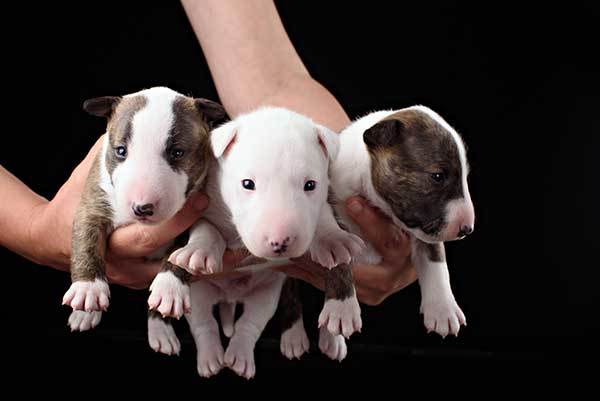
Being idiopathic, there’s no known cause of Rage Syndrome, which makes coping up with affected terriers the only effective remedy. The condition begins to show between the ages of 1 and 3.
Rage Syndrome generally manifests in spontaneous biting and sudden attacks. Before it happens, a dog will usually look dazed or confused.
And like epileptic seizures, the symptoms of Rage Syndrome often last their full cycle. That means if a dog with this condition goes on an attack, even its owner will not be able to restrain in.
Sadly, dogs with Rage Syndrome may need to be euthanized, especially if its violent outbursts are more regular and intense.
5. Bull Terrier Trancing
Lastly, trancing might also cause your Bull Terrier to be aggressive. Also known as Weed Walking or Ghost Walking, trancing refers to a bizarre behavior when a dog creeps up slowly when something touches its back.
The behavior is most common among Bull Terriers, Salukis, and Greyhounds. Trancing isn’t necessarily a precursor for aggression, but it may escalate the situation for a dog that’s already too worked up.
Correcting Bull Terrier Aggression
Bull Terrier aggression is something that’s imprinted in their DNA. The dogs are also reasonably difficult to train. That complicates things for would-be owners of Bull Terriers.
However, all is not lost. If you have your eyes set on bringing a Bull Terrier home, the good news is that you can still manage to train the dog and successfully help it redirect its violent and confrontational traits.
Now, before you even think of training a Bull Terrier, you should first identify the reasons behind the dog’s aggression. We have discussed a few possible causes of the violent behavior.
However, you must remember that like most dog breeds, Bull Terriers tend to be more aggressive in response to an external stimulus.
Understanding what causes your dog to get nervous and violent is the first step in helping to redirect this unbecoming behavior.
Another thing that makes training Bull Terriers not so difficult, after all, is that the dogs are well-tempered and highly-intelligent. They can remember places, faces, and commands from months back, which makes it easy to impart good habits in them.
When thinking of training your Bull Terrier, it’s prudent that you begin as soon as possible, possibly while the dog is still young and less aggressive.
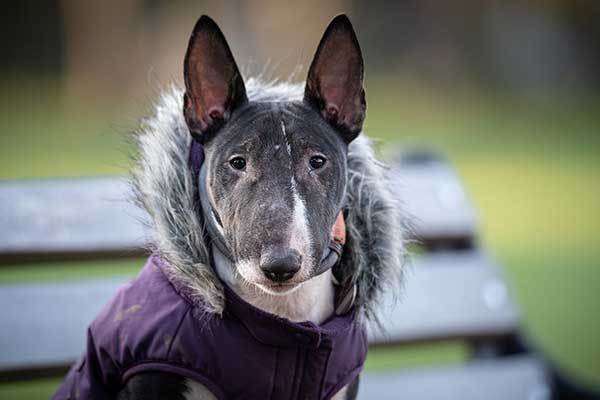
One of the possible ways you can train your Bull Terrier to be more gentle is through a method known as Negative Consequence. As the name suggests, Negative Consequence entails responding to a dog’s aggression negatively.
In this method, the dog’s owner should overtly display their disapproval for the dog’s unbecoming behavior. That ranges from a firm NO, to deterrence collars, spray of water in the face, etc.
However, it’s still paramount that you be patient with the dog even as you apply Negative Consequence. You should avoid hitting, shouting, or otherwise terrifying the dog, as doing so can be counterproductive.
Positive Reinforcement is another method you can use to train Bull Terrier to be more aggressive. This method focuses on mental stimulation and ample exercise.
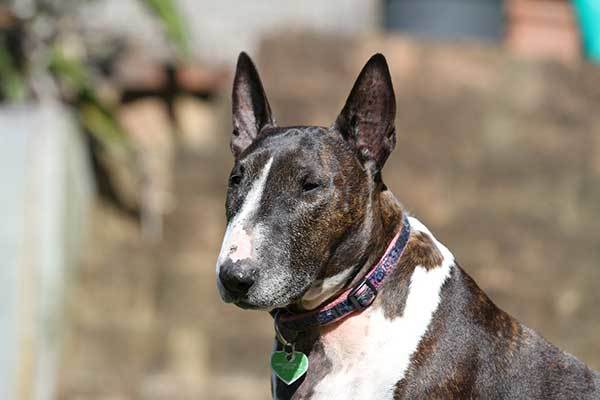
As the dog’s parent, you should spare time daily to exercise, walk, or play with your pooch. And the convention is to make the training and exercise sessions short, intense, and fun.
Positive Reinforcement also implies rewarding the dog for good behavior. For instance, if the dog begins to howl at a stranger but stops on your command, reward it with a treat. Ensure you treat the dog immediately so that it connects the reward with the action it has just done.
If it comes down to it, sign up for professional positive reinforcement classes. And ensure the trainer understands the finer traits of Bull Terriers and can adapt force-free training methods.
Begin with obedience classes and once your Bull Terrier has mastered the basics, you can proceed to more advanced classes, such as rally obedience, canine good citizen, and agility.
[thrive_text_block color=”note” headline=””]ALSO READ: How To Be A Pack Leader Of Your Dog (15 Tips) [/thrive_text_block]Should I Get A Bull Terrier?
After examining the not-so-desirable traits of Bull Terriers, you may still be wondering whether you should go ahead and bring a Bull Terrier home.
If you are a patient pet owner who can cope up with Bull Terriers’ obstinate and domineering habits, then you are a perfect candidate for a Bull Terrier parent.
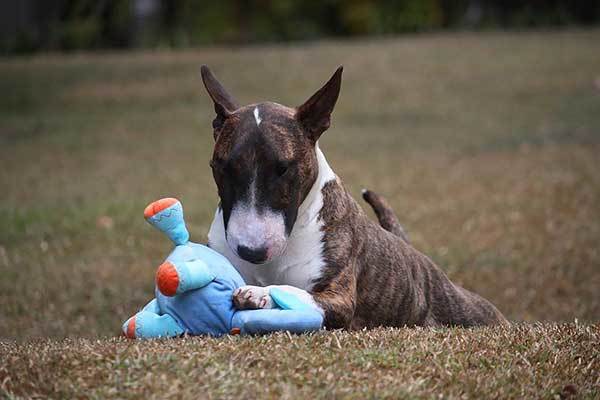
The dog is also ideal for pet owners who have a lot of time to spare in exercising, socializing, playing, and training their dogs. Besides, Bull Terriers also pack numerous other great traits, such as their cute and cocky personality, as well as their resilience and adaptability.
However, there are still some caveats to remember.
First research breeders carefully and only buy your dog from a reputable breeder. At the very least, insist on breeders that offer health clearance and guarantees.
Also, they should be able to share with you all the information on the dog you intend to buy, ranging from its physical and behavioral characteristics to mental and emotional traits.
Check if the dog has previously been diagnosed with any medical conditions, particularly those that aggravate anxiety and aggression. You can ascertain that by requesting proof of veterinary care, genetic testing, and vaccine records.
Read up reviews and recommendations on Bull Terrier breeders from reputable review websites and online community forums.
You may also check up the referral list on the Bull Terrier Club of America. Lastly, never buy a Bull Terrier from a pet store, puppy mill, or online.
So, Are Bull Terriers Dangerous Dogs?
Bull Terriers are fairly more aggressive than most dog breeds. Thankfully, you can train your terrier to be more calm and tolerant around other dogs and people.
Before acquiring the dog, ensure you understand all of its traits and are prepared to adjust to accommodate it into your lifestyle.




